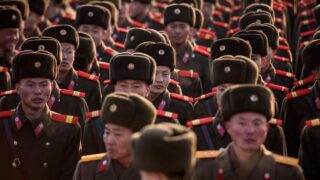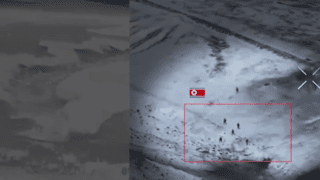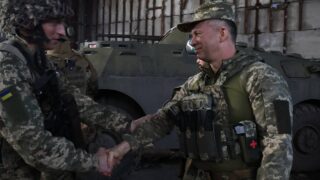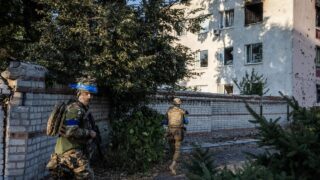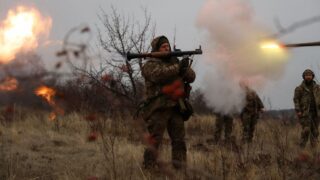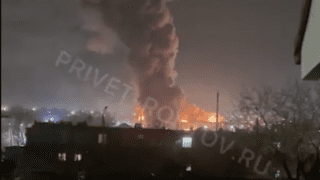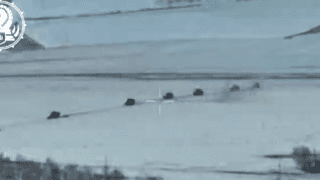
Ukraine war latest: US announces new aid package; Ukrainian drones target oil depot in Russia's Stavropol Krai
Key developments on Nov. 1:
- US announces new military aid package worth $425 million
- Ukrainian drone targets oil depot in Stavropol Krai, Russian governor claims
- Russia seizes more territory over past week than at any point in 2024, Bloomberg reports
- Russian drone strikes on Ukraine soared to record monthly levels during October, military says
- North Korean troops could suffer even greater losses in Ukraine than Russia, Estonian intelligence says
Washington announced on Nov. 1 a new military aid package for Kyiv worth $425 million, according to a U.S. Defense Department press release.
A day prior, U.S. Secretary of Defense Lloyd Austin and U.S. Secretary of State Antony Blinken said during a joint press conference that the U.S. would "soon" provide Ukraine with another aid package in light of North Korean troops' involvement in Russia's war.
The recent military assistance is provided under the Presidential Drawdown Authority (PDA) which pulls weapons from U.S. stocks.
The aid list includes munitions for NASAMS missile systems, Stinger missiles, ammunition for HIMARS rocket systems, tube-launched, optically tracked, and wire-guided (TOW) missiles, Javelin and AT-4 anti-armor systems, as well as 155mm and 105mm artillery ammunition.
Washington will also provide Kyiv with air-to-ground munitions, Stryker armored personnel carriers, counter-unmanned aerial systems (c-UAS) equipment and munitions, some medical equipment, and spare parts, among other contents of the package.
The U.S. recently allocated another military assistance package for Ukraine worth $400 million, U.S. Defense Secretary Lloyd Austin announced during his visit to Kyiv on Oct. 21.
Austin had arrived in Kyiv unexpectedly to discuss further support as the U.S. presidential election draws near.
Concerns are growing that if Republican nominee and former President Donald Trump wins against Democratic challenger Vice President Kamala Harris, he may withdraw or reduce U.S. support for Ukraine, potentially forcing the country into painful concessions.
Despite U.S. assistance, Russian forces continue grinding forward in eastern Ukraine, while the country braces for renewed strikes against its energy grid as winter approaches.
President Volodymyr Zelensky on Oct. 30 said the U.S. has transferred to Ukraine nearly 10% of the $61 billion aid approved by Congress in April 2024.


Ukrainian drone targets oil depot in Stavropol Krai, Russian governor claims
A Ukrainian drone fell on the territory of an oil depot in the town of Svetlograd in Russia's Stavropol Krai overnight on Nov. 1, Governor Vladimir Vladimirov claimed.
According to Russia's Defense Ministry, Russian air defenses overnight shot down 36 drones over Kursk Oblast, 20 over Bryansk Oblast, 12 over occupied Crimea, eight over Voronezh Oblast, four over Oryol Oblast, and three over Belgorod Oblast.
The Russian Baza Telegram channel posted a video purporting to show a drone exploding at the oil depot in Svetlograd.
The town of Svetlograd has around 35,000 residents and lies over 600 (372 miles) kilometers southeast of Ukraine's border in Donetsk Oblast.
No casualties or damage have been reported. Emergency services were at the scene, Vladimirov said.
Alexander Bogomaz, Bryansk Oblast governor, claimed that a drone hit an apartment building in the city of Bryansk overnight, injuring one person.
Kyiv has not commented on the reports, which cannot be verified independently.
In recent months, Ukrainian forces have launched a series of drone strikes aimed at damaging Russia's oil industry, whose profits fuel Moscow's war efforts.
A Ukrainian drone reportedly struck on Oct. 31 an oil refinery in the city of Ufa in Russia's Bashkortostan Republic, which lies some 1,500 kilometers from Ukraine's border.


Russia seizes more territory over past week than at any point in 2024, Bloomberg reports
Russia has seized more territory in its war with Ukraine over the past week than at any point in 2024, Bloomberg reported on Nov. 1, using Bloomberg Intelligence calculations based on the DeepState map service that tracks battlefield changes in coordination with Ukraine's Defense Ministry.
In recent months, Russian troops carried out a grinding advance in eastern Ukraine, making territorial gains while incurring heavy losses.
Russia has captured 1,146 square kilometers (442 square miles) in Ukraine since Aug. 6, about a quarter more than in the first seven months of the year, the media outlet said. The Russian military also advanced by 200 square kilometers (77 square miles) over the past week, Bloomberg reported.
As Russia makes gains on the battlefield, Ukrainian officials are growing more despondent about the future course of the war, according to one official close to President Volodymyr Zelensky's office who spoke to Bloomberg.
Meanwhile, according to Estonian intelligence, Moscow has seized 150 square kilometers (58 square miles) in the Donetsk sector of the front line over the past week.
Russian troops have reportedly captured the town of Selydove, but Ukraine has not yet confirmed the reports. Bloomberg said Russia's next targets are the towns of Poskovsk and Kurakhove, important logistical hubs for the Ukrainian military.
Observers and the Ukrainian military have previously warned of an increasingly difficult situation in the town as Russian forces have been pushing forward over the past few weeks.
The Ukrainian military said on Oct. 29 that it had repelled 11 Russian attacks in the Pokrovsk sector, including near Selydove.


Russian drone strikes on Ukraine soared to record monthly levels during October, military says
Russia launched more than 2,000 strike drones against Ukraine during October, the General Staff reported on Nov. 1, breaking the previous record set in September by nearly 700.
A total of 2,023 were recorded, according to the report. Of these, 1,185 were downed, 738 were "lost," and 29 flew back out of Ukraine's airspace.
No information was given about the remaining 71, but numerous strikes by Russian drones were reported during October, such as attacks that killed two people including a 15-year-old girl in Kyiv in recent days.
According to the General Staff, Russia has launched a total of 6,987 strike drones since the start of the year, meaning 29% of them were launched during last month.
The total number is significantly higher than September's previous record tally.
According to Ukraine's Air Force, 1,339 Shahed-type kamikaze drones targeted the country in September, 1,107 of which were shot down, with some others being jammed by electronic warfare and flying into Russian or Belarusian airspace. Around 45 were unaccounted for with no further details given.
Moscow has ramped up drone strikes, while dialing down the use of more powerful and harder-to-intercept cruise and ballistic missiles.
Experts who spoke to the Kyiv Independent said this may well be in preparation for an unprecedented mass attack rather than any sort of restraint from the Kremlin.
"UAVs (unmanned aerial vehicles/drones) can be used as pathfinders," Sidharth Kaushal, a senior research fellow at the Royal United Service Institute (RUSI), told the Kyiv Independent.
"A tool to force (an air defense) radar to light up, allowing the Russians to map the layout of defenses around Kyiv and other fairly well-defended cities."
Kaushal and other experts warn that Moscow's reliance on drones over missiles is likely a sign of a particularly large aerial attack in the near future.
"It's been quite a while since we saw a large-scale missile strike, which worries me," Fabian Hoffmann, a defense expert and doctoral research fellow at the University of Oslo, told the Kyiv Independent.
"Part of this could relate to the fact they are ramping up not just for one or two mass strikes, but perhaps several more with the objective of fully disintegrating Ukraine's electrical grid within a short period of time," he said.
"It could also be to allow for comprehensive follow-on attacks after initial blows have been dealt to make sure it cannot be effectively repaired."



North Korean troops could suffer even greater losses in Ukraine than Russia, Estonian intelligence says
North Korean troops are likely to suffer heavy losses in Ukraine, potentially exceeding those of Russia, Estonian Colonel Ants Kiviselg, head of the Estonian Defense Forces Intelligence Center, told the Estonian public broadcaster ERR on Nov. 1.
The first North Korean soldiers were deployed to Russia's Kursk Oblast in late October, Ukraine's military intelligence (HUR) reported earlier. North Korea has sent nearly 12,000 troops to Russia, including 500 officers and three generals, according to HUR.
North Korean soldiers are usually trained to fight in mountainous terrain, which means they are not familiar with Ukrainian territory, its climate, and geography, Kiviselg said.
"Their training does not include combat operations in such conditions, and the training they receive in the Russian Federation is certainly not of a very high level," Kiviselg said.
"Therefore, we can expect North Korean units to suffer heavy losses in Ukraine, and probably even more than the Russian Federation's forces have suffered so far."
He said that the North Korean troops arrived in Kursk Oblast in "early October," having previously undergone two to four weeks of training. Following this, North Korean soldiers redeployed to the "Ukrainian front," Kiviselg added.
"The arrival of North Korean soldiers on the Ukrainian front will likely take place in stages," Kiviselg said.
"If this additional deployment of (North Korean) units in Russia, their training, and then arrival on the Ukrainian front continues in the long term, it could certainly bring some changes to the front line."
Some 8,000 North Korean troops have been deployed to Russia's Kursk Oblast to participate in the war against Ukraine, according to U.S. intelligence.
According to the Financial Times, Ukrainian intelligence officials are skeptical regarding the combat effectiveness of the North Korean troops, citing communication issues with their Russian counterparts as the main hurdle Moscow and Pyongyang will have to bridge.
North Korea's entry into the war comes when Russia's long and grinding campaign in Ukraine's eastern Donetsk Oblast has dramatically gained pace in recent days. Analysts say Russian forces are advancing at a pace not seen since the early months of the war.








